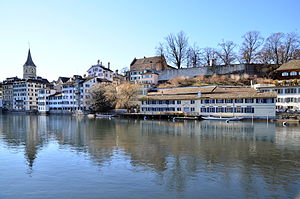Turicum (Zürich)

Lindenhof hill, Schipfe and the Roman wall of the later Pfalz fortifications, as seen from Limmatquai, Weinplatz to the left.
|
|
| Alternate name | Turegum, Turico |
|---|---|
| Location | Lindenhof–Sihlbühl–Münsterhof-Weinplatz-Limmatquai |
| Region | former Germania Superior, present city of Zürich, Canton of Zürich, Switzerland |
| Coordinates | 47°22′22″N 8°32′26″E / 47.37278°N 8.54056°ECoordinates: 47°22′22″N 8°32′26″E / 47.37278°N 8.54056°E |
| Type | Vicus |
| Part of | Lindenhof hill (Zürich) respectively Oppidum Zürich Lindenhof |
| Length | about 500 metres (1,640 ft) Sihlbühl–Bürkliplatz, Grosser Hafner island excluded |
| Width | about 200 metres (656 ft) Augustinergasse–Limmatquai |
| History | |
| Material | stone and wood |
| Founded | Probably around 15 BC |
| Abandoned | Around 401 AD by the Roman army, settlement continued by Gallo-Roman inhabitants |
| Periods | Roman Republic to Roman Empire |
| Cultures | Helvetii and Gallo-Roman |
| Site notes | |
| Excavation dates | 1906, 1937, 1989, 1997, 1998-2001, 2004, 2007, 2008 and 2014 at Lindenhof hill, Münsterhof, Weinplatz (Thermengasse), Rennweg, Augustinergasse, St. Peterhofstatt, Münzplatz, Schipfe (Limmat) and Grosser Hafner |
| Archaeologists | Margrit Balmer, Dölf Wild |
| Condition | aeaorchological access |
| Ownership | City of Zürich |
| Management | City of Zürich |
| Public access | Thermengasse and so-called Lindenhofkeller showing the Celtii, Gallo-Roman and Carolinum walls. |
Turicum is the Latin name of the Swiss municipality of Zürich and one of the most important archaeological sites in the canton of Zürich. In Roman times, Turicum was a tax-collecting point respectively vicus at the border of the Roman provinces Gallia Belgica (from AD 90 Germania Superior) and Raetia for goods trafficked on the waterway Walensee-Obersee-Zürichsee passing Centum Prata (Kempraten) towards the rivers Limmat, Aare and Rhine from and towards the Roman heartland over the mountain passes of the Swiss Alps.
The ancient name Turicum and the fact that in the present city of Zürich was an imperial Roman customs station, is known thanks to the inscription on the grave stone those Latin inscription refers to STA(tionis) TURICEN(sis) as the Roman customs stations situated there. The original gravestone dates from 185/200 AD and was found on the Lindenhof hill. The gravestone was erected for Lucius Aelius Urbicus, a one-year-old child, by his parents Unio, freedman of Augustus, and Aelia Secundina.
The earliest manuscript mention of the settlement, as castellum turegum, describes the mission of Columbanus in 610. An 8th-century list of toponyms by the so-called Geographer of Ravenna mentions Ziurichi. The Latin name may be derived from Turīcon, a Celtic name of a personality called Tūros.
On the then swamp area between Limmat and Lake Zurich around the present Sechseläutzenplatz plaza, there were Neolithic pile dwellings which were set on piles to protect its inhabitants against occasional flooding by the rivers Sihl, Linth and Jona. Three settlements were located in Enge, a locality of the municipality of Zürich: Zürich–Enge Alpenquai and Kleiner Hafner on then islands or peninsulas on the effluence of the Limmat, and Grosser Hafner, as well as the settlement Kleiner Hafner near the present Sechseläutenplatz plaza on the effluence of the Limmat on Lake Zurich lake shore, all within an area of about 0.2 square kilometres (49.42 acres) some 500 metres (1,640 ft) away of the core of the Celtic Oppidum respectively the Roman era Vicus.
...
Wikipedia

